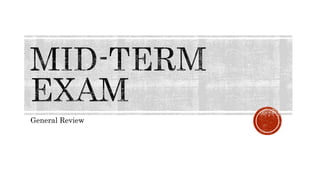
General Review
- 2. Countable and Uncountable Some, Any and Do How Much, How Many, A little, A few Object Personal Pronouns Simple Past Affirmative Negative Questions Differences between Can and Could Verbs in Past
- 4. A bottle of … A glass of … A cup of … A can of … A bowl of … A slice of …
- 5. Countable nouns are all the things that we can count, for example, a pen. We can have one, two, three, or more pens. Uncountable nouns are substances, concepts, etc. that we cannot divide into separate elements. We are not able to "count" them
- 7. We use some with uncountable and plural countable nouns, in AFFIRMATIVE sentences and OFFERS Luis Roberto Ortiz We use any with uncountable and plural countable nouns, in NEGATIVE sentences and QUESTIONS We use any with uncountable and plural countable nouns, in AFFIRMATIVE sentences. It is used instead of not any
- 8. SOME ANY NO Uncountable and plural countable nouns Affirmative sentences and Offers Negative sentences and Questions Affirmative sentences, instead of not any Luis Roberto Ortiz
- 10. We use How Much with UNCOUNTABLE nouns to ask about the quantity of something Luis Roberto Ortiz We use How Much with plural COUNTABLE nouns to ask about the number of something.
- 12. We use Much with UNCOUNTABLE nouns, in QUESTIONS and NEGATIVE sentences. Luis Roberto Ortiz We use Many with PLURAL COUNTABLE nouns, usually in QUESTIONS and NEGATIVE sentences
- 13. We use Lot of/Lots of with UNCOUNTABLE and PLURAL COUNTABLE nouns, in AFFIRMATIVE sentences. Luis Roberto Ortiz We use A little with UNCOUNTABLE nouns, in AFFIRMATIVE sentences. We use A few with PLURAL COUNTABLE nouns, in AFFIRMATIVE sentences.
- 15. Object pronouns are used instead of nouns, usually because we already know what the object is. It makes the sentence easier to read and understand and avoids repetition. We normally use object pronouns after a verb or a preposition.
- 16. Are used as subjects and go before the verb. Luis Roberto Ortiz Are used after the verb as objects or after prepositions.
- 17. Subjects are what the sentence is about. Objects are what is affected by the action of the subject
- 18. SUBJECT OBJECT I Me You You He Him She Her It It We Us You You They Them • She is Laura, the sister of Jeremy. • They are Uncle Ben and Aunt Sally. • I play the piano everyday. • We are the first team in the contest. • That is her house, the green one. • The red box is for them. • She was shouting at me. • I guess the punishment is not for us.
- 20. We use the Simple Past to talk about things that happened in the past. Luis Roberto Ortiz PAST FUTUR E PRESEN T
- 21. Verbs Regular Irregular Luis Roberto Ortiz
- 22. For regular verbs, we only add “ed” at the end of the verb. Luis Roberto Ortiz Play Played Talk Talked Stay Stayed Jump Jumped
- 23. 1. Verbs ending in –e, only add a –d at the end 2. Verbs ending in a consonant + -y, add –ied 3. Verbs with one syllable ending in CVC form, double the last consonant. 4. Verbs with 2 or more syllables ending in the CVC form and with the last stressed syllable 5. Verbs ending in one vowel + -L, double the –L before the –ed Luis Roberto Ortiz
- 24. Luis Roberto Ortiz Irregular verbs are different from each other, so, you need to learn one by one the cases. Look at the list on page 137
- 25. HAVE HAD GET GOT BUY BOUGHT MAKE MADE COME CAME EAT ATE LEAVE LEFT DO DID GO WENT SEE SAW Luis Roberto Ortiz
- 28. I You He She It We They Did Comp.Verb in simple form Luis Roberto Ortiz
- 29. We use the verb should to ask or give advice The verb should remains the same in all persons Luis Roberto Ortiz Guerrero
